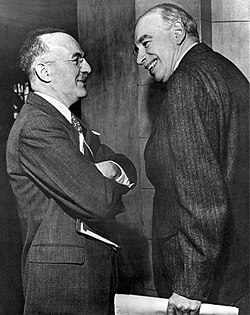
The World Trade Organization (WTO) is an intergovernmental organization which regulates international trade. The WTO officially commenced on 1 January 1995 under the Marrakesh Agreement, signed by 123 nations on 15 April 1994, replacing the General Agreement on Tariffs and Trade (GATT), which commenced in 1948. [2] The WTO deals with regulation of trade between participating countries by providing a framework for negotiating trade agreements and a dispute resolution process aimed at enforcing participants' adherence to WTO agreements, which is signed by representatives of member governments [3] : fol.9–10 and ratified by their parliaments. [4] Most of the issues that the WTO focuses on derive from previous trade negotiations, especially from the Uruguay Round (1986–1994).
Contents
- GATT rounds of negotiations
- From Geneva to Tokyo
- Uruguay Round
- Ministerial conferences
- Doha Round (Doha Agenda)
- References
The World Trade Organization's predecessor, the General Agreement on Tariffs and Trade (GATT), was established after World War II in the wake of other new multilateral institutions dedicated to international economic cooperation – notably the Bretton Woods institutions known as the World Bank and the International Monetary Fund. A comparable international institution for trade named the International Trade Organization was successfully negotiated. The ITO was to be a United Nations specialized agency and would address not only trade barriers but other issues indirectly related to trade, including employment, investment, restrictive business practices, and commodity agreements. But the ITO treaty was not approved by the U.S. and a few other signatories and never went into effect. [5] [6] [7]
In the absence of an international organization for trade, the GATT would over the years "transform itself" into a de facto international organization. [8]
